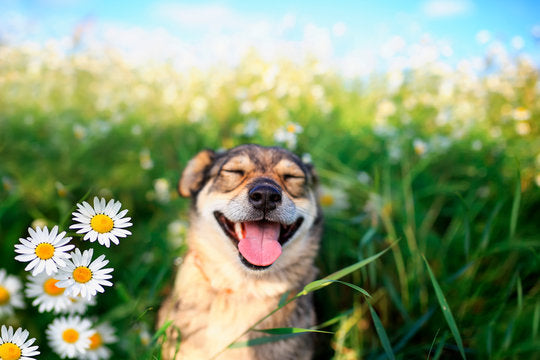
How To Care For Your Dog In Spring
Share
How to Care For Your Dog in The Spring
Spring is a beautiful time of year, with warmer weather, blooming flowers, and longer walks outdoors. However, this season also brings unique challenges for dog owners. From allergies to toxic plants, fleas, and ticks, there’s a lot to watch out for. This guide will help you understand the importance of caring for your dog in the spring and keeping them safe, happy, and healthy.

Watch Out for Spring Allergies
Just like humans, dogs can suffer from seasonal allergies in the spring. Pollen from trees, grass, and flowers can cause discomfort, leading to itching, sneezing, and watery eyes. Some dogs may even develop skin irritations or ear infections due to allergic reactions.
Common Symptoms of Dog Allergies:
Excessive scratching or licking
Red, irritated skin
Runny nose or watery eyes
Ear infections or head shaking
How to Help:
Wipe your dog's paws and fur after outdoor play to remove pollen.
Bathe your dog with a hypoallergenic shampoo to soothe irritated skin.
Consult your vet about antihistamines or allergy treatments if symptoms persist.
- Keep your dog indoors on high pollen count days.
- Use an air purifier to reduce allergens in your home.
Beware of Toxic Plants and Garden Chemicals
Spring means gardening season , but many flowers and plants can be toxic to dogs. Popular spring blooms like daffodils, tulips, and lilies can cause serious health issues if ingested.
Common Toxic Plants:
Tulips & Daffodils – Can cause vomiting, diarrhea, and drooling.
Azaleas & Rhododendrons – Highly toxic and can lead to organ failure.
Lilies – Extremely dangerous, especially for cats, but also harmful to dogs.
Garden Chemicals like pesticides and fertilizers can also be harmful. Keep your dog away from treated lawns and always rinse their paws if they walk on chemically treated areas.
Safe Alternatives:
Use pet-friendly fertilisers and pesticides.
Create a designated dog-friendly space in your garden.
Train your dog to avoid nibbling on plants.
Easter Treats: The Dangers of Chocolate
Easter is a fun holiday, but it also poses a hidden danger for dogs – chocolate . Even small amounts can be toxic, leading to serious health issues.
Signs of Chocolate Poisoning:
Increased heart rate or restlessness
Tremors or seizures in severe cases
Vomiting or diarrhoea
What to Do If Your Dog Eats Chocolate:
Call your vet immediately for advice.
Try to determine how much chocolate they ate.
In some cases, your vet may suggest inducing vomiting or providing activated charcoal.
Fleas and Ticks: Springtime Pests
Warmer weather brings an increase in fleas and ticks , which can cause serious health problems like Lyme disease and skin infections.
How to Check for Fleas and Ticks:
Inspect your dog’s fur after walks in grassy areas .
Look for small, dark specks (flea dirt) or tiny bugs.
Check behind the ears, neck, and underbelly for ticks.
Preventative Measures:
Use flea and tick prevention treatments recommended by your vet.
Wash bedding and vacuum regularly to eliminate flea eggs.
Keep your lawn and outdoor spaces tidy to reduce flea habitats.
Spring Coat Care for Your Dog
As the temperature rises, dogs begin to shed their winter coat . Regular grooming helps to remove excess fur and keep their skin healthy.
Grooming Tips:
Brush your dog daily to prevent matting and remove loose fur.
Use a deshedding brush if your dog has a thick coat.
Give your pup a bath with moisturizing shampoo to keep their skin fresh.
Trim excess fur around paws to prevent dirt buildup.
Check for signs of dry skin or irritation and use dog-friendly moisturizers.
Standing Water: Hidden Dangers
Spring rains often lead to puddles and stagnant water , which can harbor bacteria and parasites, such as Leptospirosis .
Risks of Standing Water:
Leptospirosis – A bacterial infection that affects the kidneys and liver.
Parasites – Mosquitoes and other bugs lay eggs in still water.
Chemicals – Some puddles contain runoff from fertilizers or pesticides.
Blue-Green Algae – Some bodies of water develop harmful algae that can be fatal to dogs.
How to Protect Your Dog:
Avoid letting your dog drink from puddles or standing water.
Carry fresh water and a bowl on walks.
Make sure your dog’s vaccinations are up to date.
If your dog loves water, stick to clean, running streams or lakes that are known to be safe.

Keeping Your Dog Safe This Spring
Caring for dogs in spring involves more than just enjoying the sunshine. Be aware of seasonal allergies , toxic plants, and dangerous chemicals. Protect your dog from fleas and ticks , and groom them regularly to keep their coat healthy. Be mindful of standing water and never let your dog consume Easter chocolate . By following these tips, you can ensure your furry friend stays happy and healthy all season long.
How can I tell if my dog has allergies?
Look for signs like itching, sneezing, watery eyes, and red skin . If your dog seems uncomfortable, consult your vet for allergy treatments.
What should I do if my dog eats a toxic plant?
Call your vet immediately . Try to identify the plant and monitor your dog for symptoms like vomiting or lethargy.
How often should I check my dog for fleas and ticks?
Daily checks after outdoor play are ideal, especially if your dog spends time in grassy areas.
Is it safe to let my dog drink from puddles?
No, standing water can contain harmful bacteria, parasites, or chemicals. Always bring fresh drinking water for your dog.
What flea prevention methods work best?
Vets often recommend topical treatments, flea collars, or oral medications . Keeping your home and yard clean also helps prevent infestations.

Bella's Box



